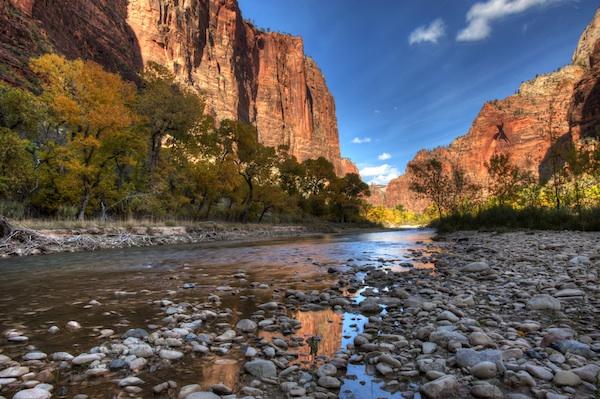
National parks generated $26.5 billion in economic activity last year. Zion National Park contributed $185.5 million/Deby Dixon photo of Zion Canyon
"This property is of no value to the Government."
"...if it cannot be occupied and cultivated, why should we make a public park of it? If it cannot be occupied by man, why protect it from occupation? I see no reason in that."
How times have changed.
Those two statements, the first from U.S. Sen. John Conness in 1864 as he urged the chamber to protect the Yosemite Valley, and the second from Sen. Cornelius Cole in 1872 in opposing legislation to create Yellowstone National Park, painted two of the more glorious units of today's National Park System as worthless tracts of land. Today they are viewed as part of a $26.5 billion economic engine that supports 240,000 jobs and countless businesses, large and small.
While Sen. Conness had to persuade his colleagues that Yosemite was worthless, and Sen. Cole believed Yellowstone to be worthless, today the National Park Service points to the economic worth of the parks.
'National parks are often the primary economic engines of many park gateway communities,' Park Service Director Jon Jarvis said last week in announcing the fiscal impacts of the park system. 'While park rangers provide interpretation of the iconic natural, cultural and historic landscapes, nearby communities provide our visitors with services that support hundreds of thousands of mostly local jobs.
"... The big picture of national parks and their importance to the economy is clear,' the director added. 'Every tax dollar invested in the National Park Service returns $10 to the U.S. economy because of visitor spending in gateway communities near the 401 parks of the National Park System.'
Lodging is the biggest business in the park system, generating $4.4 billion in economic activity last year, notes the report, 2013 National Park Visitor Spending Effects, Economic Contributions to Local Communities, States, and the Nation. Next in line, not too surprisingly, is dining and drinking (yes, bar drinking), which contributed $2.9 billion.
In 2013, NPS visitors spent a total of $14.6 billion in local gateway communities while visiting NPS lands. These expenditures directly supported over 143 thousand jobs, $4.2 billion in labor income, $6.9 billion in value added, and $11.2 billion in output in the national economy. The secondary effects of visitor spending supported an additional 94 thousand jobs, $5.0 billion in labor income, $8.8 billion in value added, and $15.3 billion in output in the national economy. Combined, NPS visitor spending supported a total of 238 thousand jobs, $9.2 billion in labor income, $15.6 billion in value added, and $26.5 billion in output in the national economy.
Which park system unit contributed the most to that total? The Blue Ridge Parkway, which generated nearly $1 billion ($999.3 million) in business last year, according to the report, followed closely by Great Smoky Mountains National Park with $943.2 million.
The report also noted that overall visitation to the parks was down in 2013, in large part due to the partial government shutdown in October, and due to ongoing impacts from Hurricane Sandy, which swept up the Eastern Seaboard in October 2012.
What was not part of the report, but which would be equally important in assessing the overall value of the National Park System, would be an analysis of the ecological worth of the parks. What value are the forests that act as air and water filters? How important to the nation are the flora and fauna protected by the parks? Let's measure the ecological, and economic, value of coastal wetlands and barrier islands at places such as Everglades National Park, Gulf Islands National Seashore, and Assateague Island National Seashore, that not only provide critical habitat for shorebirds, waterfowl, and fish, but also serve as storm buffers.
If the Park Service feels it must tout the dollar-impact of the parks to generate Congressional and public support, it could similarly bolster that argument by defining the "natural capital" that resides in the park system.
"Nature has provided ecosystems and their benefits to us for free. However, perhaps because this capital has been provided freely to us, we humans have tended to view it as limitless, abundant, and always available for our use, exploitation, and conversion. The concept of an ecosystem as natural capital can help us analyze the economic behavior that has led to the overuse of so much ecological wealth. If we can understand this behavior better, then perhaps we can find ways to manage and enhance what is left of our natural endowment. -- Edward B. Barbier, Capitalizing on Nature, Ecosystems as Natural Assets.



Comments
I am so glad to hear that our national parks are making Big Money. I was indeed worried there for a moment that untrammeled nature was all they offered.
Don't worry too much Alfred. Those are, for the most part, manfuactured numbers.
ec, please show us some proof of that allegation.
If anyone thinks that national parks are not paying their own way, come to Gatlinburg, TN, one of the gateway towns to Great Smoky Mountains National Park.
Visitors spend on motel rooms, meals, trinkets and serious camping equipment and ice cream. And that includes me.
Danny www.hikertohiker.com
Lee - read the analysis. It is full of assumptions. The most blatant and erroneous of which is that people would not spend the money elsewhere if parks didn't exist.
ecbuck, I thought the point is; they would spend money elsewhere if the parks didn't exist not the other way around.
Yes, David, people would spend elsewhere. The report assumes otherwise.
And non "wealthy" alike